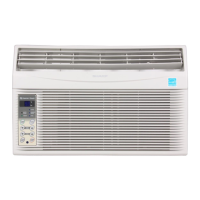R-410A Refrigerant Overview
The U.S. Clean Air Act of 1990 and the Montreal
Protocol call for the phaseout of HCFC-22 (commonly
known as R-22). This has caused manufacturers to
replacement for the standard R-22 refrigerant.
The EPA is not mandating the use of R-410A. They
are mandating that R-22 can no longer be used in new
equipment in 2010, and production of R-22 will cease in
2020. Manufacturers must use alternative refrigerants,
and so far, most of them are choosing R-134A or R-410A.
However, R-407C is being used in many rooftop units and
other refrigerants as well, depending on the application.
The major difference between R-22 and R-410A is the
cantly higher pressures involved with using R-410A.
The pressure-temperature chart for R-410A compares
the pressures of R-410A versus R-22 (Figure 6-1). This
chart shows how high the pressures are within the sealed
system. In general, R-410A pressures are 1.8 times
higher than those of R-22.
It also is important to note that R-410A is not to be used
t applications and that only compressors that are
designed for R-410A refrigerant should be used. R-410A
refrigerant uses Polyol Ester oil, which is hygroscopic,
and can be irritating to skin, but it also improves heat
transfer. R-410A is a binary (two part), near-azeotropic
mixture, and is presently marketed under the brand
names of AZ-20, Puron, and Suva. The closer a blend
comes to being a true azeotrope, the less temperature
Temperature glide occurs when a refrigerant has a range
of temperature in which it will boil and condense at one
pressure. The lower the temperature the less chance it
will fractionate. R-410A has less then 0.3 degrees of
temperature glide. R-407C has a high temperature glide
and may fractionate into its component refrigerants, but
it is still a good replacement for R-22. Some refrigerants
ammable when fractionated. This
different leakage rate is caused from the different partial
pressure of each constituent. To avoid fractionation,
liquid charging should be done whenever possible and
should be transferred from the refrigerant tank as liquid.
When adding liquid refrigerant into the low side of the
compressor, make sure the liquid is throttled to avoid
Pure and azeotropic refrigerants have no fractionation
or temperature glide. Although some R-22 indoor coils
meet the UL approved design and service pressure
rating of 235 psig, always con
manufacturer before using R-22 indoor coils with R-410A.
R-22 Pressure Pressure R-410A
Refrigerant Vapor Pressures
R-410A is incompatible with R-22 refrigerant. R-410A is
used at much higher operating pressures than R-22
and other newer refrigerants.
Filter-driers used with R-22 refrigerants are not
compatible with an R-410A sealed system. When
replacing a filter-drier in an R-410A system, make sure
the replacement filter drier is specifically designed for

